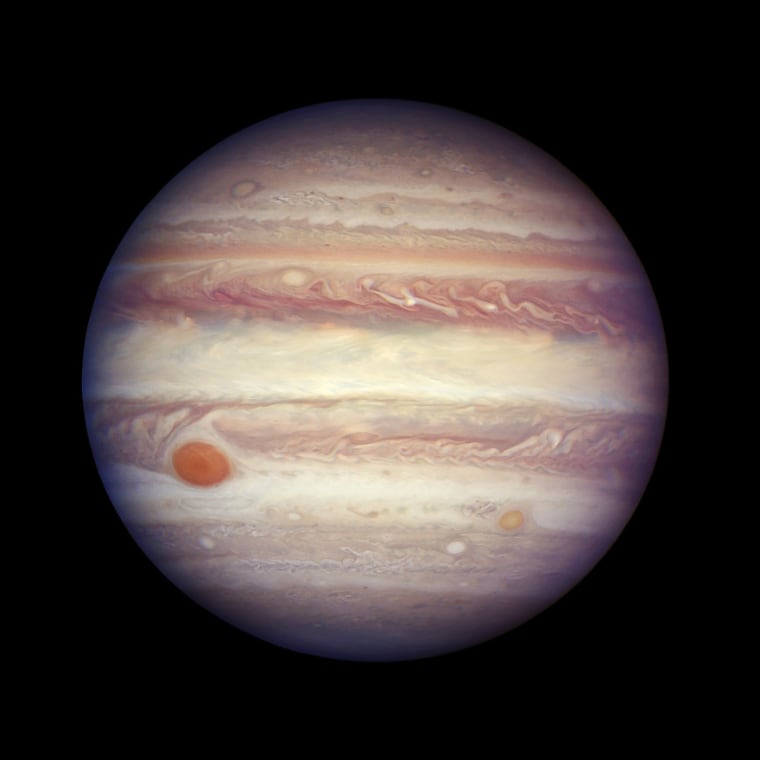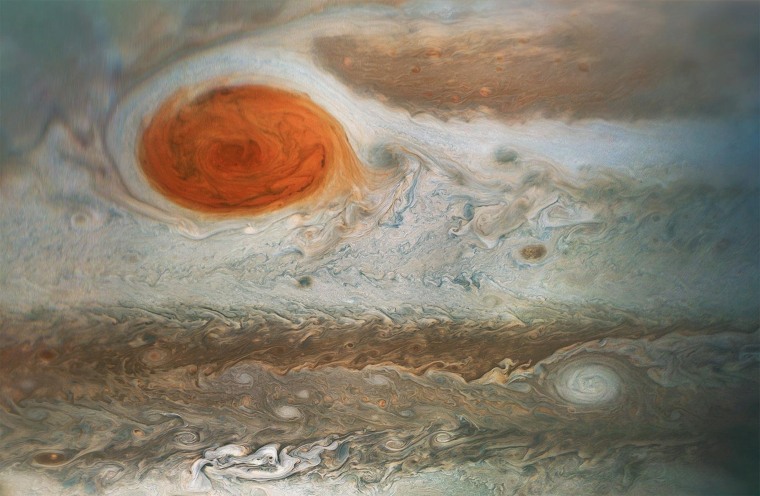Jupiter’s Great Red Spot — a vast storm that’s lasted for hundreds of years — is shaped like a pancake floating amid the clouds of the gas giant’s outer atmosphere and doesn’t reach deep into its interior, according to new research on data from NASA’s Juno space probe.
Two new studies, published Thursday in the journal Science, give the first accurate estimation of the depth of the Great Red Spot and show that while it’s deeper than expected, it doesn’t extend far into the planet’s atmosphere, as once theorized.
Instead, it is shaped like a thin lens over 10,000 miles wide, although it may be fed by upwellings of deeper gas, said Scott Bolton, the lead author of one of the studies and a co-author of the other. Bolton is the director of the space science and engineering division at the Southwest Research Institute in San Antonio and the principal investigator for the Juno mission.
“It’s much, much wider than it is deep — it’s like a pancake to some extent,” he said. “The surprising part was most of the models that people have played around with had it being much shallower.”
The space probe has been in orbit around Jupiter since 2016, evaluating its chemical composition, measuring its gravitational and magnetic fields, and taking photographs of the planet and its many moons — 79 at last count.
Among its investigations is the nature of the Great Red Spot, which was first documented in the 1800s but may have been seen before that by astronomers in the 1600s, who reported seeing spots on Jupiter through telescopes.
It’s often brick-red — hence its name — but its color varies over weeks and months to salmon, yellow, gray and even white. Scientists think its color may be the result of sunlight changing the chemical composition of the clouds of the ammonia, ammonium hydrosulfide and water it’s probably made of.

Similar storms have been seen between Jupiter’s distinctive stripes, which are caused by rising or falling “jet streams” of winds that reach as deep as 1,800 miles below the clouds. Many of the storms have been observed for years, but none have lasted as long as the Great Red Spot.
Astronomers reported it was “flaking” a few years ago, and perhaps getting smaller. But scientists think it will keep going for a long time, and recent research has found the winds in the Great Red Spot are getting faster.
To study the Great Red Spot, the Juno probe was reoriented from its normal sideways attitude, so that the microwave radiometer on board could better reveal details of its vertical structure.
Juno also examined two other vast storms in Jupiter’s atmosphere, one that rotated counterclockwise like the Great Red Spot and another that rotated in the opposite direction.
By comparing details of the different storms, the researchers found that all three extended deeper into the atmosphere than they expected, and that the Great Red Spot was the deepest.
The second study used minute variations in the Juno spacecraft’s orbit as it crossed over the Great Red Spot to determine its mass.
Led by Marzia Parisi, a research scientist at NASA’s Jet Propulsion Laboratory in Pasadena, California, the study determined that the bulk of the Great Red Spot could extend no deeper than about 300 miles below its visible surface.
Taken together, both studies confirm the Great Red Spot is roughly shaped like a pancake, visible above the cloud tops, but not reaching deep into Jupiter’s interior. The planet itself has a diameter of roughly 90,000 miles.
“The new Juno microwave and gravity data provide spectacular confirmation of two key discoveries made using Voyager data over a quarter century ago,” said Timothy Dowling, a professor of dynamic meteorology at the University of Louisville in Kentucky, who was not involved in the new studies. “Jupiter’s jet streams are deep and its great storms are shallow vortex lenses.”
He likens the Great Red Spot and similar storms on Jupiter not to hurricanes on Earth that are driven by convection from the ocean surface, but to submerged ocean features called “meddies” — a contraction of “Mediterranean Eddies”, because they carry salt-rich water from the Mediterranean Sea into the Atlantic Ocean.
Meddies are gently spinning regions of water hundreds of feet beneath the ocean surface that can last for several months, until they collide with a seamount on the ocean floor or a piece of land — neither of which exist on Jupiter, which is thought to consist mainly of gaseous hydrogen at extreme pressures that forms metallic hydrogen thousands of miles deeper down, he said.
Although there is always the possibility that the Great Red Spot could someday break apart, such a vast storm is likely to last for a very long time, perhaps hundreds or thousands of years. “It’s much simpler than a hurricane, and it has absolutely no reason to fall apart — it just goes on and on,” he said.
